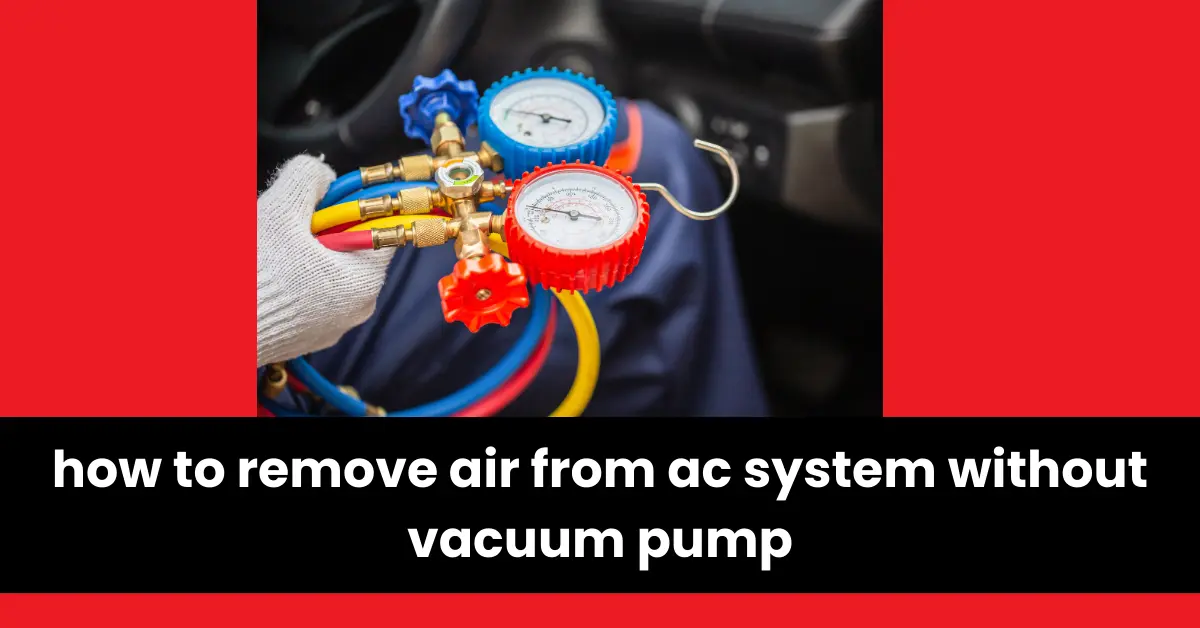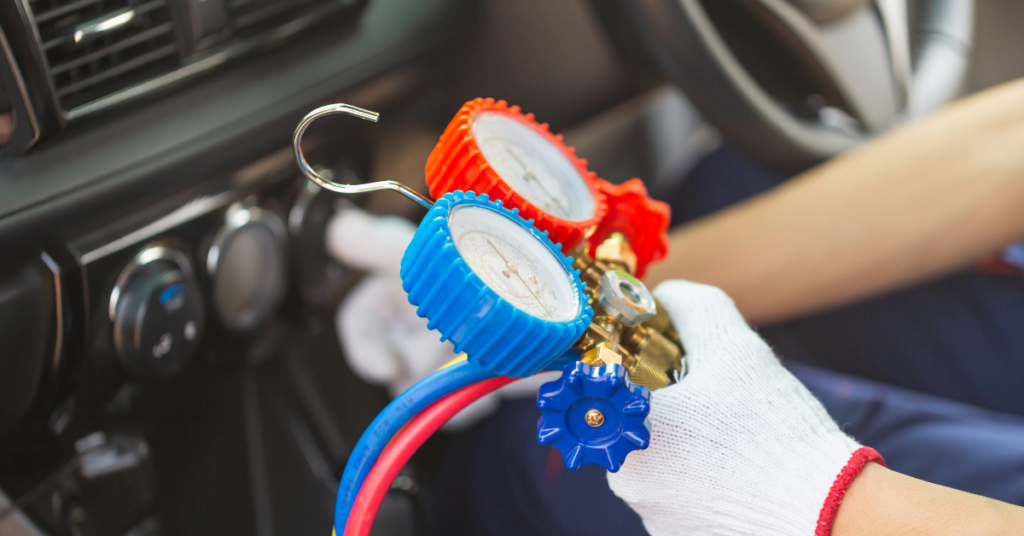
Air conditioning systems play a crucial role in maintaining a comfortable temperature in our homes and cars, especially during the hot summer months.
However, over time, air can become trapped in the AC system, leading to reduced efficiency and poor cooling performance. While a vacuum pump is typically used to remove air from the AC system, it may not always be readily available.
But don’t worry! In this article, we will guide you through the process of removing air from your AC system without the need for a vacuum pump. So, let’s get started!
Contents
- 1 Understanding the AC System
- 2 Tools and Materials
- 3 How to Remove Air from AC System Without a Vacuum Pump | Step-By-Step Process
- 3.1 Step 1: Safety First
- 3.2 Step 2: Locate the Low-Pressure Port
- 3.3 Step 3: Attach the AC Pressure Gauge
- 3.4 Step 4: Start the Engine and Turn on the AC
- 3.5 Step 5: Check the Pressure Reading
- 3.6 Step 6: Slowly Add Refrigerant
- 3.7 Step 7: Monitor Pressure and Repeat
- 3.8 Step 8: Check for Cool Air
- 3.9 Step 9: Test and Recharge (if necessary)
- 4 FAQ
- 4.1 Q: Can I remove air from my AC system without a vacuum pump?
- 4.2 Q: What tools and materials do I need to remove air from my AC system without a vacuum pump?
- 4.3 Q: How do I remove air from my AC system without a vacuum pump?
- 4.4 Q: Should I consult a professional for assistance in removing air from my AC system without a vacuum pump?
Understanding the AC System
Before we delve into the air removal process, it’s important to have a basic understanding of how an AC system works. An AC system is made up of various components, such as the compressor, condenser, evaporator, expansion valve, and refrigerant lines.
The refrigerant, which is usually a gas or liquid, plays a vital role in transferring heat and cooling the air. However, when air enters the system, it can disrupt this process and diminish the overall performance.
Tools and Materials
To effectively remove air from your AC system without a vacuum pump, you’ll need the following tools and materials:
AC pressure gauge

This will enable you to monitor the pressure levels inside the system as you remove the air.
Refrigerant recharge kit
This kit allows you to add refrigerant to the system and push the air out.
Screwdrivers or wrenches
These tools will come in handy when accessing certain components of the AC system.
Safety gloves and goggles
It is crucial to prioritize your safety while working with high-pressure refrigerants.
Rag or cloth
This will help you clean any spills or messes that may occur during the process.
New refrigerant (if necessary)
In some cases, you may need to replace the existing refrigerant with a new one.
How to Remove Air from AC System Without a Vacuum Pump | Step-By-Step Process
Now that you have all the necessary tools and materials, let’s go through the step-by-step process of removing air from your AC system:
Step 1: Safety First
Before you start any work, ensure your safety by wearing gloves and goggles. AC systems contain high-pressure refrigerants that can be harmful if mishandled, so it’s crucial to take the necessary precautions.
Step 2: Locate the Low-Pressure Port
Next, you need to locate the low-pressure port in your AC system. This port is typically found on the larger diameter line between the compressor and the evaporator. If you’re unsure about its exact location, consult your vehicle or AC system’s manual for guidance.
Step 3: Attach the AC Pressure Gauge
Once you’ve identified the low-pressure port, attach the AC pressure gauge to it. The pressure gauge will allow you to monitor the pressure levels inside the system as you remove the air.
Step 4: Start the Engine and Turn on the AC

Start your vehicle’s engine and switch on the AC system. This step is crucial as it activates the compressor, allowing the refrigerant to circulate through the system.
Step 5: Check the Pressure Reading
Observe the pressure reading on the AC pressure gauge. If the reading is significantly low, it is an indication that there is air trapped in the system.
Step 6: Slowly Add Refrigerant
Using the refrigerant recharge kit, slowly add refrigerant to the system. Make sure to follow the instructions provided with the kit to ensure you are adding the correct amount. Adding refrigerant will help push the air out of the system.
Step 7: Monitor Pressure and Repeat
As you add refrigerant, keep an eye on the pressure gauge. It should gradually increase. If you notice any abnormal pressure readings or fluctuations, stop adding refrigerant and consult a professional for further assistance.
Step 8: Check for Cool Air
Once you’ve added the necessary refrigerant, check the air coming out of the vents. If the air is cool and the AC system is functioning correctly, you have successfully removed the air from the system.
Step 9: Test and Recharge (if necessary)
To ensure optimal performance, it’s recommended to have a professional technician test your AC system and recharge it if needed. They have the expertise and equipment to detect any underlying issues and ensure the system is in top-notch condition.
Here are some additional tips to keep in mind:
Regularly inspect and maintain your AC system to prevent air from entering in the first place. This includes checking for leaks, cleaning or replacing filters, and scheduling professional maintenance.
If you suspect a significant amount of air has entered the system, it’s always best to consult a professional for a thorough inspection and air removal process.
Remember to dispose of any old refrigerant or containers responsibly, following local regulations.
By following these steps and tips, you can effectively remove air from your AC system without the need for a vacuum pump. However, if you encounter any difficulties or are unsure about any aspect of the process, it’s always recommended to seek professional assistance.
A well-maintained and air-free AC system will ensure optimal cooling performance and maximize your comfort during hot summer days!
FAQ
Q: Can I remove air from my AC system without a vacuum pump?
Yes, you can remove air from your AC system without a vacuum pump by following a step-by-step process.
Q: What tools and materials do I need to remove air from my AC system without a vacuum pump?
You will need an AC pressure gauge, a refrigerant recharge kit, screwdrivers or wrenches, safety gloves and goggles, a rag or cloth, and new refrigerant if necessary.
Q: How do I remove air from my AC system without a vacuum pump?
The process involves steps such as ensuring safety, locating the low-pressure port, attaching the AC pressure gauge, starting the engine and turning on the AC, checking the pressure reading, slowly adding refrigerant, monitoring pressure, checking for cool air, and testing and recharging if necessary.
Q: Should I consult a professional for assistance in removing air from my AC system without a vacuum pump?
If you encounter any difficulties or are unsure about any aspect of the process, it is recommended to seek professional assistance for a thorough inspection and air removal process.



